Located in the Great Lakes of the United States, Indiana is home to several varieties of wildlife, birds of prey like Owls.
The state has 25 different state parks and three national parks, namely, George Rogers Clark National Historic Park, Indiana Dunes National Park, and Lincoln Boyhood National Memorial.
Indiana is characterized by its continental climate, which means that they have very cold winters and warm summers, mainly humid. Regarding owls, the state of Indiana is home to eight known species.
These species include the Long-eared Owl, the Northern Saw-whet Owl, the Barn Owl, the Eastern Screech Owl, the Snowy Owl, the Great Horned Owl, the Barred Owl, and the Short Eared Owl.
The Short-Eared Owl is the easiest species to spot, while the Barred Owl is the rarest owl to spot in Indiana. In this article, we’ll focus on the different species of owls that you can spot in Indiana, the sounds they make, how and where you might spot them.
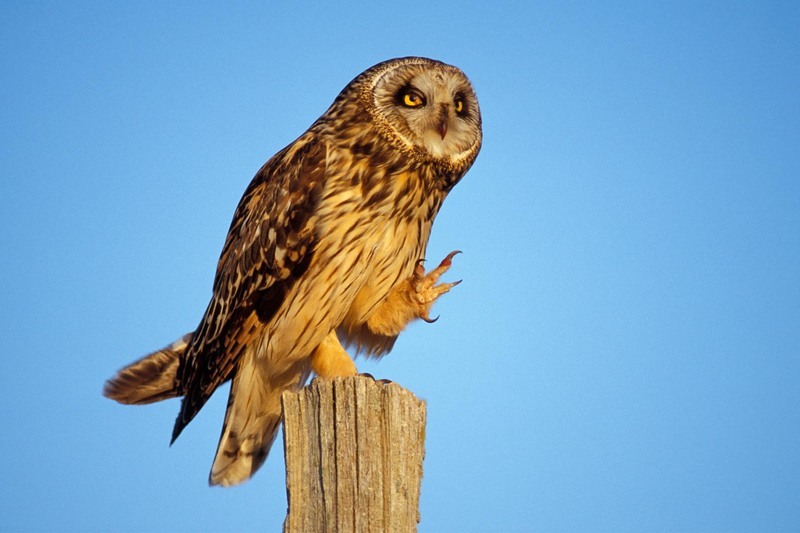
1. Short-eared Owl
This is undoubtedly the most common and easy to spot owls in Indiana. These owls are found throughout Indiana, and they can be easily spotted in the Northern parts all year round.
However, for the southern parts of Indiana, the Short-eared owls can only be spotted during their breeding seasons. These owls are known to make a sound that resembles a bark or a scream. As the name suggests, this owl species have very small ears that it might be hard for you to spot in the distance.
The Short-eared owls are medium in size, a buff that covering entire bodies with most of them downing brown feathers. The most likely place to spot this own species is in the open grasslands.
These owls are also known to fly very long distances during hunting and their breeding seasons. Interestingly, the Short-eared owl’s subspecies is the only native owl found in all over Hawaii. The Short-eared owls often use the nights for hunting since their courtship displays often take place during the day.
The biggest role for the male Short-eared owl is to protect the female owl after mating while she incubates her eggs. Foe the bigger animals that might threaten their nests, this species of owls is known to perform a series of distraction displays for them. The largest number of this species is often seen in the north-eastern part of the state.
Here are their measurements;
Length: 13.4-16.9 inches.
Wingspan: 33.5-40.5 inches.
Weight: 7.3-16.8 oz.
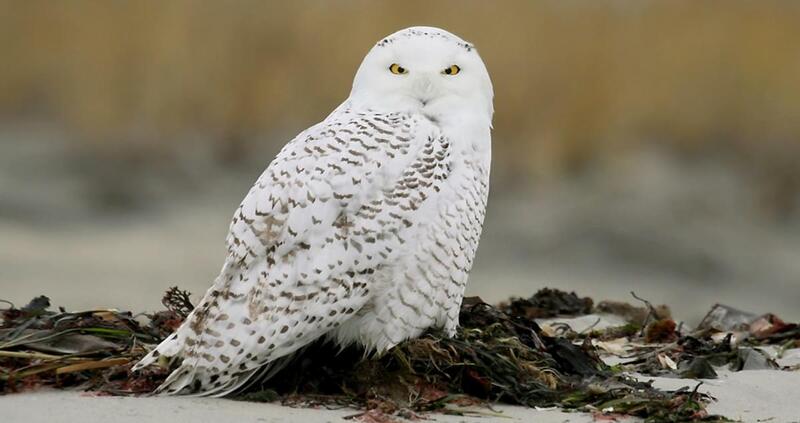
2. Snowy Owl
This owl species is commonly found in the arctic regions since they are more comfortable in their tundra habitat. For any owl, the Snowy owl is medium to large in size, and they are often regarded by many as one of the most beautiful owl species in the world.
This species of owls are often covered in white feathers, while some of them have grey-tipped feathers. What makes it very hard to mistake this species from any other is that they lack ear tufts and a very loud booming sound, “hoo, hoo.”
Among the different species of owls, the Snowy owls are regarded to be some of the most aggressive. This is because they’re likely to attack any humans or even wolves that come close to their territories. These owls also have a unique way of mating.
In the state of Indiana, these owls are commonly seen during the winter seasons. You’re likely to spot the Snowy Owl around the Northern parts of Indiana. They are known to frequent along the shores of Lake Michigan. For their breeding, the Snowy Owls often migrate to the arctic tundra areas of Canada or Northern Greenland.
Here are their measurements;
Length: 20.5-27.9 inches.
Wingspan: 49.6-57.1 inches.
Weight: 56.4-104.1 oz.
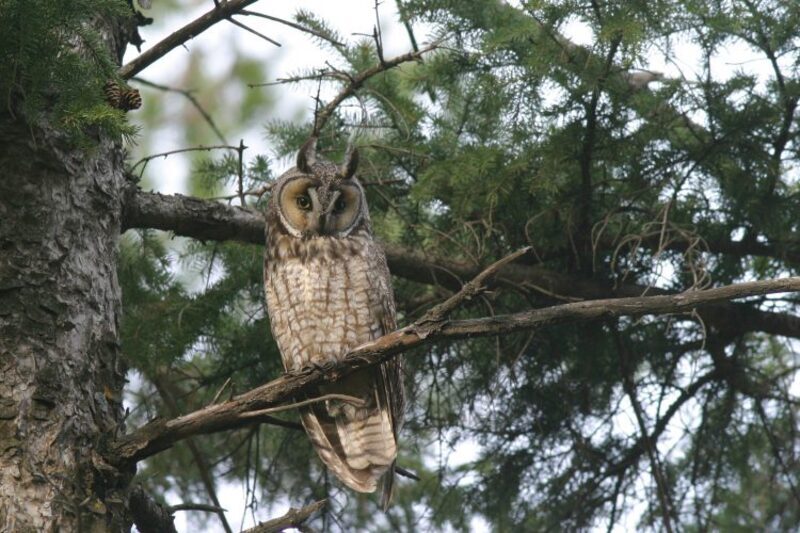
3. Long-eared Owl
You’re likely to spot this owl species in the forests and woodlands all over Indiana’s Northern and Central regions. However, it’s important to note that this owl species is only spotted in Indiana during its breeding season and not all year round.
Due to their territorial nature, they occupy very bigger spaces for their habitats. They make sounds that take after a bleating lamb. As the name suggests, these owls often have very long ears compared to other species.
The Long-eared owls are very fierce and silent, and they feed on mammals or occasionally other birds. One of the unique behaviors of this owl species is that they tend to swallow their prey whole and bring up the unneeded parts in the form of pellets.
The male Long-eared owl is one of the loudest owls you can spot as you can hear its call up to a mile away. During their breeding season, these owls are known to form colonies which consist of up to 100 owls.
An interesting fact about the male Long-eared owls is they tend to remain monogamous to their breeding partners.
Here are the Long-eared owls’ measurements;
Length: 13.8-15.8 inches.
Wingspan: 35.4-39.4 inches.
Weight: 7.8-15.3 oz.

4. Great Horned Owl
The Great Horned Owls are some of the biggest owls in Indiana. Among all owls, this species is the easiest to recognize due to its large ears, yellow eyes, and tufts. This owl species makes a unique soft hoot accompanied by a stuttering rhythm like “hoo-hoo-hoo”.
Most of these owls have their entire bodies covered in mottled grey feathers. The species is regarded as the Great Horned Owl because they have large feather tufts on their heads that greatly resemble horns.
With this species, it’s not certain to tell their habitat range, but you’re most likely to spot the in dense forests, although in recent times, they have been spotted in the sub-Saharan areas like city parks.
Like the Long-eared Owl, the Great Horned Owl also mates monogamously and is known to breed with the same partners for a very long time. Both the male and female of this species take part in guarding their territories against intruders.
This owl species is also very aggressive, as there have been reported incidents of these owls killing their own. The Great Horned Owl is a permanent resident in Indiana, and you can spot it in the state throughout the year.
The most common sightings of this species have been reported in the South-Eastern part of the state. An interesting fact about the Great Horned Owl is that it is the only bird known to hunt and eat skunks while also being enemies with the Red-Tailed Hawk.
Their measurements are;
Length: 18.1-24.8 inches.
Wingspan: 39.8-57.1 inches.
Weight: 32.1-88.2 oz.
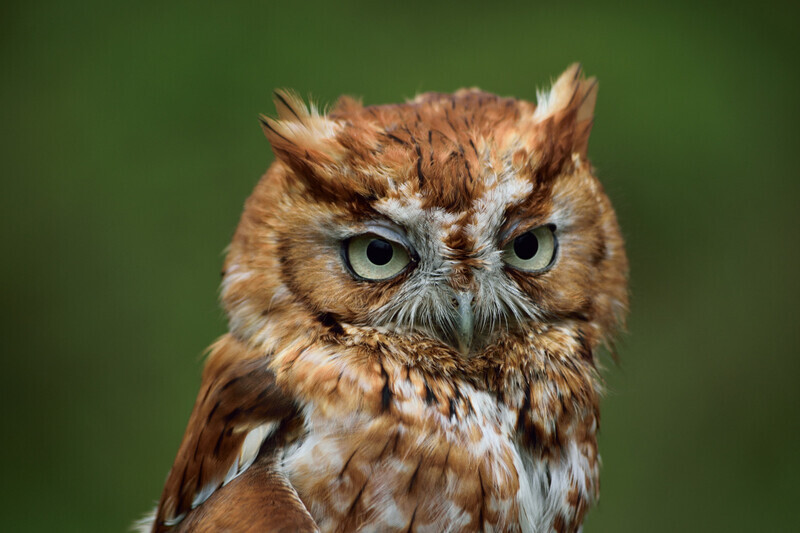
5. Eastern Screech-Owl
This owl species is easily recognizable due to its large head and a barely visible neck. The Easter Screech-Owls are often very short and stocky, and their bodies are covered by grey feathers.
This gives them a camouflage look that makes it easy for them to hide behind barks of trees without being spotted. The Easter Screech-Owl is one of the few owl species that are not particularly picky about their habitats.
These owls will create a territory anywhere provided there is a dense forest to cover them. For its sound, the Eastern Screech-Owl makes an even pitched trill and a descending whiney. This owl species is known to feed on a variety of things from songbirds, insects to rodents.
For those who would like to attract a mating partner for their domestic owl, this owl species can take up residence in any nest boxes you have. Like most owls, the male Eastern Screech-Owl remains with one mating partner for a long time.
However, during the seasons why prey is hard to come by, the male Easter Screech-Owl will mate with two females. The female owls in this species are known to produce one brood in a season. This brood often consists of 2-6 eggs.
You can spot this owl species anywhere in Indiana all-year-round. However, the most sightings of the Eastern Screech-Owl have been in the Northern parts of Indiana.
Their measurements are;
Length: 6.3-9.8 inches.
Wingspan: 18.9-24.0 inches.
Weight: 4.3-8.6 oz.
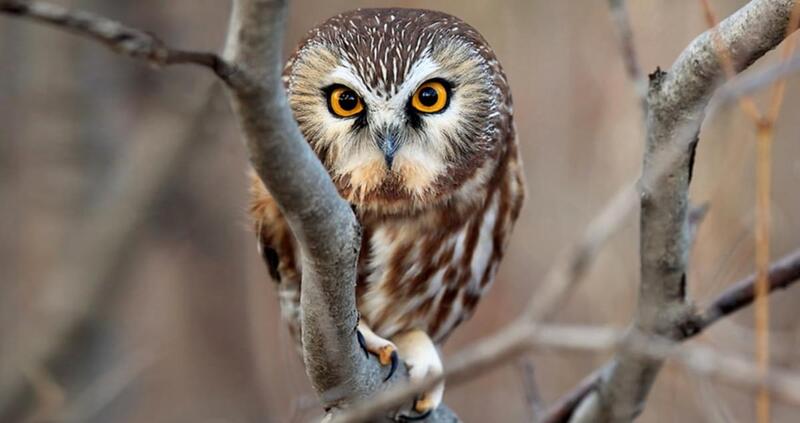
6. Northern Saw-Whet Owl
They are among the most common owls in Indiana. Although they are found in almost all over Indiana, many sightings have been in the Northern parts. They are only spotted in the Southern and Central regions of Indiana during their breeding seasons.
The lowest sightings for this owl species have been in the Southern-eastern part of the state. The Northern Saw-whet Owl is the smallest species of owls you’ll find not only in Indiana but in the whole of the United States.
This species often have very wide orange eyes that you can spot from a distance. The Northern Saw-Whet owls are mainly covered in brown feathers all over their bodies, and their bellies are usually white in color.
It’s also important to note that even though their coloring pattern is mostly the same among these owls, the shades of brown on their feathers might vary. These owls get their name from the fact that they produce a sound similar to a saw being sharpened on a Whetting stone.
The Northern Saw-whet Owl mostly resides in areas of dense woodlands, more so during their breeding season. These owls are known to feed mostly on mice, during their breeding season and also feed on songbirds and insects.
Unlike other owl species, the Northern Saw-whet Owl doesn’t remain with the same mate for long. They find a new mating partner in every breeding season. Due to their small size, this owl species are often attacked and preyed upon by other bigger owls, such as the Great Horned Owl.
Their measurements are;
Length: 7.1-8.3 inches.
Wingspan: 16.5-18.9 inches.
Weight: 2.3-5.3 oz.
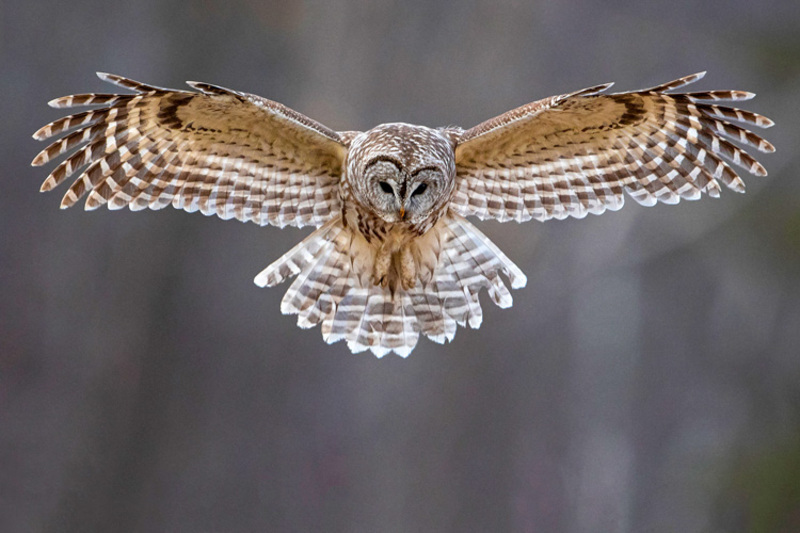
7. Barred Owl
This owl species gets its name from the barred patterns of its wings. The Barred Owl wings are brown and white in color, making the owl very hard to identify. These owls commonly create their territories in the woodlands close to swamps.
The Barred Owls, like most of the owl species, spend most of the nights hunting and days roosting. For these owls, the responsibility to defend their territories is carried out by both males and females.
The Barred owls tend to remain monogamous to their mating partners for a very long time. You can spot this owl species in all seasons throughout Indiana, although the most sightings have been recorded in the South-eastern part of the state.
These owls are known to make a very distinctive sound which sounds like they are saying, “Who Cooks for you, Who cooks for you all?.” The unique trait about these owls is that they never migrate during any season; summer, winter, or even their breeding season.
It has even been confirmed that these owls never move over 6 miles away from their nests. The barred owls are also easily preyed on, mostly by the Great Horned Owl.
Their measurements are;
Length: 16.9-19.7 inches.
Wingspan: 39.0-43.3 inches.
Weight: 16.6-37.0 oz.

8. Barn Owl
This is among the most beautiful owls in Indiana. They are medium-sized and have very long, rounded wings. Even though they might appear mostly white to onlookers, these owls are covered in grey feathers.
The Barn owls don’t hoot like most owls but rather make a very long and harsh scream. These owls are among the most common ones to spot all over Indiana. The Barn Owl often forms a habitat in the grasslands and is mainly monogamous throughout the breeding season.
The male Barn owl is known to have a unique courtship display that involves performing a move known as the ‘moth flight’ in front of the female. The female Barn owls usually lay between 2-18 eggs per brood.
Even though these owls are common all over Indiana, most of their sightings have been recorded in the Sothern regions of the state. The hunting capabilities of these owls are among the most advanced for any owl since they can track their prey by sound alone.
Their measurements are;
Length: 12.6-15.8 inches.
Wingspan: 39.4-49.2 inches.
Weight: 14.1-24.7 oz.
Conclusion
The above-listed species are the most common ones to spot throughout Indiana. Whether you’re a domestic or foreign tourist and are looking to spot owls in Indiana, you can rest assured there’s a good chance you’ll get to see an owl as they are very abundant.
Related
- Owls are one of the many birds that are nocturnal, and tend to be vocal at night. But they aren’t the only birds making noise. We explore this more in: Why Are Birds Chirping At Night?
- Owls make some very interesting sounds. From the well known hoot, to the almost horse-like sound the Eastern Screech Owl makes — it can be fun to keep a journal and learn how to identify birds by their sounds in night time conditions.
Leave a Reply